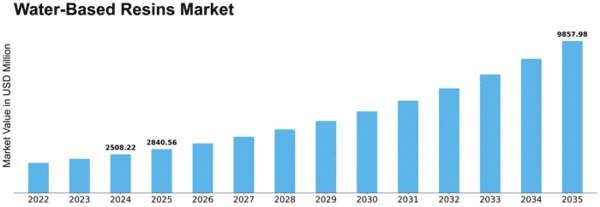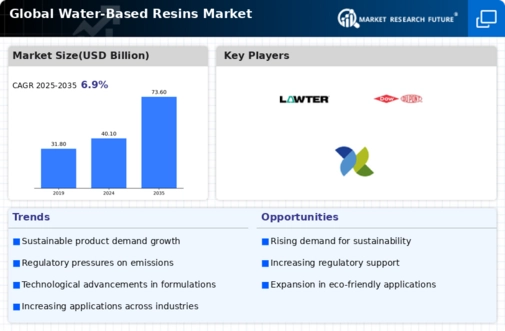-
Executive Summary
-
Scope of the Report
-
Market Definition
-
Scope of the Study
- Research Objectives
- Assumptions & Limitations
-
Markets Structure
-
Market
-
Research Methodology
-
Research Process
-
Secondary Research
-
Primary Research
-
Forecast Model
-
Market Landscape
-
Porter’s Five Forces Analysis
-
Bargaining Power of Buyers
-
Rivalry
-
Threat of New Entrants
-
Threat of Substitutes
-
Segment
-
Value Chain/Supply Chain of Global Water-Based Resins Market
-
Industry Overview of Global Water-Based Resins Market
-
Introduction
-
Growth Drivers
-
Impact Analysis
-
Market Challenges
-
Market Trends
-
Introduction
-
Growth Trends
-
Impact
-
Analysis
-
Global Water-Based Resins Market, by Type
-
Introduction
-
Acrylic Resin
- Market Estimates & Forecast, 2020–2027
- Market Estimates & Forecast by Region, 2020–2027
-
Epoxy
- Market Estimates & Forecast, 2020–2027
-
Ester Resin
-
Market Estimates & Forecast by Region, 2020–2027
-
Saturated Polyester
- Market Estimates & Forecast, 2020–2027
- Market
-
Resin
-
Estimates & Forecast by Region, 2020–2027
-
Epoxy Resin
- Market Estimates &
-
Market Estimates & Forecast, 2020–2027
-
Forecast by Region, 2020–2027
-
Polyurethane Resin
- Market
- Market Estimates & Forecast
-
Estimates & Forecast, 2020–2027
-
by Region, 2020–2027
-
Alkyd Resin
- Market Estimates &
- Market Estimates & Forecast by Region,
-
Forecast, 2020–2027
-
Others
- Market Estimates & Forecast, 2020–2027
- Market Estimates & Forecast by Region, 2020–2027
-
Global
-
Water-Based Resins Market, by Application
-
Introduction
-
Paints
- Market Estimates & Forecast, 2020–2027
-
& Coatings
-
Market Estimates & Forecast by Region, 2020–2027
-
Adhesives &
- Market Estimates & Forecast, 2020–2027
-
Sealants
-
Market Estimates & Forecast by Region, 2020–2027
-
Inks
- Market Estimates &
-
Market Estimates & Forecast, 2020–2027
-
Forecast by Region, 2020–2027
-
Leather
- Market Estimates
- Market Estimates & Forecast by Region,
-
& Forecast, 2020–2027
-
Others
- Market Estimates & Forecast, 2020–2027
- Market Estimates & Forecast by Region, 2020–2027
-
Global
-
Water-Based Resins Market, by Region
-
Introduction
-
North America
- Market Estimates & Forecast, 2020–2027
- Market Estimates
- Market Estimates & Forecast
- US
- Canada
-
& Forecast by Type, 2020–2027
-
by Application, 2020–2027
-
Forecast, 2020–2027
-
Market Estimates & Forecast by Application, 2020–2027
-
Europe
- Market Estimates & Forecast, 2020–2027
- Market Estimates
- Market Estimates & Forecast
- Germany
- France
- Spain
- UK
- Russia
- Poland
-
& Forecast by Type, 2020–2027
-
by Application, 2020–2027
-
& Forecast, 2020–2027
-
Type, 2020–2027
-
Italy
-
Market Estimates & Forecast by Type, 2020–2027
-
& Forecast by Application, 2020–2027
-
Estimates & Forecast, 2020–2027
-
by Type, 2020–2027
-
Market Estimates & Forecast by Application, 2020–2027
-
& Forecast by Type, 2020–2027
-
by Application, 2020–2027
-
& Forecast, 2020–2027
-
Type, 2020–2027
-
Asia-Pacific
- Market Estimates & Forecast,
- Market Estimates & Forecast by Type, 2020–2027
- Market Estimates & Forecast by Application, 2020–2027
- India
- Japan
- Australia
- New Zealand
- Rest of Asia-Pacific
-
China
-
Market Estimates & Forecast by Type, 2020–2027
-
& Forecast by Application, 2020–2027
-
Estimates & Forecast, 2020–2027
-
by Type, 2020–2027
-
Market Estimates & Forecast by Application, 2020–2027
-
& Forecast by Type, 2020–2027
-
by Application, 2020–2027
-
& Forecast, 2020–2027
-
Type, 2020–2027
-
Forecast, 2020–2027
-
Middle East & Africa
- Market Estimates & Forecast, 2020–2027
- Market Estimates & Forecast by Type, 2020–2027
- Market
- Turkey
- Israel
- North Africa
- GCC
- Rest of the Middle East & Africa
-
Estimates & Forecast by Application, 2020–2027
-
Market Estimates & Forecast, 2020–2027
-
Forecast by Type, 2020–2027
-
Application, 2020–2027
-
Forecast, 2020–2027
-
Market Estimates & Forecast by Application, 2020–2027
-
& Forecast by Type, 2020–2027
-
by Application, 2020–2027
-
Estimates & Forecast by Type, 2020–2027
-
& Forecast by Application, 2020–2027
-
Latin America
- Market Estimates &
- Market Estimates & Forecast by
- Brazil
- Argentina
- Mexico
- Rest of Latin America
-
Market Estimates & Forecast, 2020–2027
-
Forecast by Type, 2020–2027
-
Application, 2020–2027
-
Forecast, 2020–2027
-
Market Estimates & Forecast by Application, 2020–2027
-
Estimates & Forecast by Type, 2020–2027
-
& Forecast by Application, 2020–2027
-
Estimates & Forecast by Type, 2020–2027
-
& Forecast by Application, 2020–2027
-
Company Landscape
-
Company Profiles
-
BASF SE
- Company Overview
- Type/Business
- Financial Updates
- Key Developments
- Company Overview
- Type/Business Segment Overview
- Financial Updates
- Key Developments
-
Segment Overview
-
Lawter Inc.
-
DowDuPont
- Type/Business Segment Overview
- Financial
- Key Developments
-
Company Overview
-
Updates
-
Allnex Group
- Company
- Type/Business Segment Overview
- Financial Updates
- Key Developments
-
Overview
-
The Lubrizol Corporation
- Company
- Type/Business Segment Overview
- Financial Updates
- Key Developments
-
Overview
-
Hexion
- Company Overview
- Financial Updates
- Key Developments
-
Type/Business Segment Overview
-
Royal DSM NV
- Company Overview
- Type/Business Segment
- Financial Updates
- Key Developments
-
Overview
-
DIC
- Company Overview
- Type/Business Segment Overview
- Financial Updates
- Key Developments
-
Corporation
-
Arkema
- Type/Business Segment Overview
- Financial
- Key Developments
-
Company Overview
-
Updates
-
BELIKE Chemical
- Company
- Type/Business Segment Overview
- Financial Updates
- Key Developments
-
Overview
-
Vil Resins
- Company Overview
- Type/Business Segment Overview
- Financial Updates
-
Key Developments
-
Arakawa Chemical Industries Ltd
- Company
- Type/Business Segment Overview
- Financial Updates
- Key Developments
-
Overview
-
KITO Chemical Co. Ltd
- Company
- Type/Business Segment Overview
- Financial Updates
- Key Developments
-
Overview
-
Conclusion
-
LIST OF TABLES
-
Table 1
-
Water-Based Resins Market, by Region, 2020–2027
-
North America:
-
Water-Based Resins Market, by Country, 2020–2027
-
Europe: Water-Based
-
Resins Market, by Country, 2020–2027
-
Asia-Pacific: Water-Based
-
Resins Market, by Country, 2020–2027
-
Middle East & Africa:
-
Water-Based Resins Market, by Country, 2020–2027
-
Latin America:
-
Water-Based Resins Market, by Country, 2020–2027
-
Water-Based
-
Resins Type Market, by Region, 2020–2027
-
North America: Water-Based
-
Resins Type Market, by Country, 2020–2027
-
Europe: Water-Based
-
Resins Type Market, by Country, 2020–2027
-
Asia-Pacific: Water-Based
-
Resins Type Market, by Country, 2020–2027
-
Middle East &
-
Africa: Water-Based Resins Type Market, by Country, 2020–2027
-
Table
-
Latin America: Water-Based Resins Type Market, by Country, 2020–2027
-
Water-Based Resins Application Market, by Region, 2020–2027
-
North America: Water-Based Resins Application Market, by Country, 2020–2027
-
Europe: Water-Based Resins Application Market, by Country, 2020–2027
-
Asia-Pacific: Water-Based Resins Application Market, by Country,
-
Middle East & Africa: Water-Based Resins Application
-
Market, by Country, 2020–2027
-
Latin America: Water-Based Resins
-
Application Market, by Country, 2020–2027
-
Global Type Market,
-
by Region, 2020–2027
-
Global Application Market, by Region,
-
North America: Water-Based Resins Market, by Country,
-
North America: Water-Based Resins Market, by Type,
-
North America: Water-Based Resins Market, by Application,
-
Europe: Water-Based Resins Market, by Country, 2020–2027
-
Europe: Water-Based Resins Market, by Type, 2020–2027
-
Table
-
Europe: Water-Based Resins Market, by Application, 2020–2027
-
Table
-
Asia-Pacific: Water-Based Resins Market, by Country, 2020–2027
-
Table
-
Asia-Pacific: Water-Based Resins Market, by Type, 2020–2027
-
Table
-
Asia-Pacific: Water-Based Resins Market, by Application, 2020–2027
-
Table
-
Middle East & Africa: Water-Based Resins Market, by Country, 2020–2027
-
Middle East & Africa: Water-Based Resins Market, by Type, 2020–2027
-
Middle East & Africa: Water-Based Resins Market, by Application,
-
Latin America: Water-Based Resins Market, by Country,
-
Latin America: Water-Based Resins Market, by Type,
-
Latin America: Water-Based Resins Market, by Application,
-
LIST OF FIGURES
-
Water-Based Resins Market
-
Segmentation
-
Forecast Methodology
-
Porter’s Five
-
Forces Analysis of Water-Based Resins Market
-
Value Chain/ Supply Chain
-
of Water-Based Resins Market
-
Share of Water-Based Resins Market, by
-
Country, 2020 (%)
-
Water-Based Resins Market, 2020–2027
-
FIGURE
-
Sub-Segments of Type
-
Water-Based Resins Market Size, by Type, 2020
-
Share of Water-Based Resins Market, by Type, 2020–2027
-
FIGURE
-
Sub-Segments of Application
-
Water-Based Resins Market Size, by
-
Application, 2020
-
Share of Water-Based Resins Market, by Application,


















Leave a Comment